Contents
Every gardener knows perfectly well that the key to a rich harvest is the observance of agricultural technology and conscientious care of plants. When growing grape bushes, the most important and responsible procedure is spring pruning of grapes. The condition of the vine, the quantity, and most importantly, the quality of the future harvest depend on this event.
Do you need to cut
Grapes love the sun very much, so its shoots stretch upwards. And the fruits seem to accumulate solar energy in themselves, pouring juice, and are ready to thank the summer resident for his work and care.
But the peculiarity of grapes is that it continuously forms a large number of new shoots. Chaotic, uneven growth of shoots is strongly reflected in the formation of buds. Weak, sparse buds, in turn, are the cause of the appearance of a small number of inflorescences, most of which are empty flowers. This affects the taste of the fruit – the grapes will be small and very sour.
Grapes direct most of the nutrients to the upper, developing, young shoots. And if there are too many actively growing branches on the bush, there is practically no strength left for the formation, growth, and ripening of fruits. Sometimes a powerful, strong vine is simply unable to produce a large amount of grapes.
Pruning grapes in the spring allows you to form a vine, timely removing excess and damaged shoots, which ensures high yields.
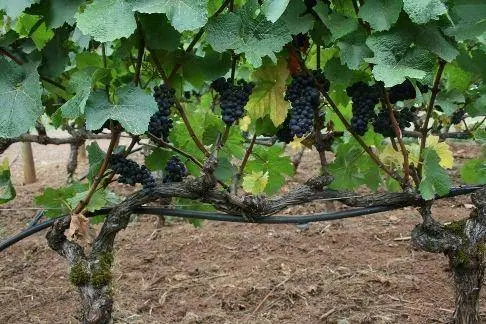
If this event is excluded or carried out in violation of the rules and terms of pruning, the grapes will gradually overgrow, the berries will shrink every year, the bush will run wild, and varietal characteristics will be lost forever.
Therefore, the correct pruning of grapes in the spring is a kind of renewal of the bush, which has the following goals:
- Cleaning of frozen, diseased, and damaged branches;
- Thinning to form a standard or non-standard bush;
- Increase in productivity;
- Improving the taste characteristics of grapes;
- Preservation of varietal characteristics.
Perhaps, after pruning, it will seem to you that the grapes look unsightly. But this is the whole point of pruning so that the sun’s rays can adequately illuminate both the upper and lower parts of the vine.
When to prune: spring or fall
The time and timing of pruning depends on many factors. Of great importance is the grape variety, its age, the method of cultivation, as well as the climatic conditions of the growing region.
Late-ripening varieties are usually pruned in autumn by growers. While grape varieties with early and medium ripening are usually pruned in early spring.
Frost-resistant varieties are also pruned in the fall, 15-20 days after the leaves fall. But grape varieties that do not have good frost resistance are best cut in early spring.
Young, not yet formed bushes are subject to mandatory pruning in the spring.
The method of growing grapes is also of great importance in determining the timing of pruning. So, with a non-covering method of growing grapes are pruned in the autumn. But if you are sheltering grape bushes for the winter, then in this case you should give preference to spring pruning.
Many gardeners prefer to prune a fruit-bearing grape bush in the fall, and form young grapes with the help of spring pruning.
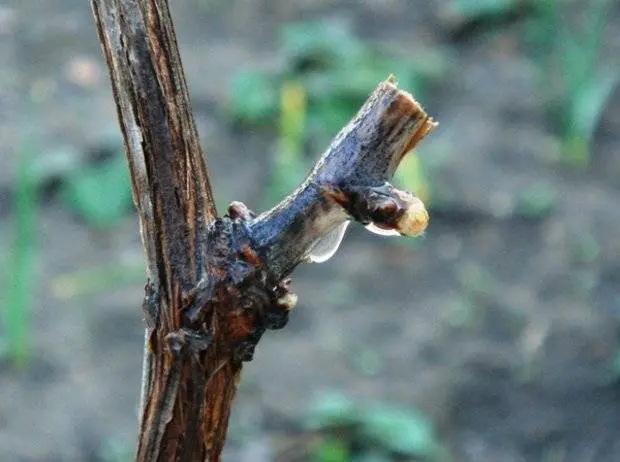
Before cutting the grapes in the spring, it would be useful for beginner summer residents to know that the event must be completed before active sap flow begins. Molasses flows out of open cuts. It’s almost impossible to stop her. A large loss of life-giving juice adversely affects the growth of the vine. If you are even a little late with pruning, you can lose the future crop, and possibly the entire bush.
Usually summer residents, when determining the optimal time when grapes can be cut in spring, are guided by two criteria. The first is the air temperature 5˚С-7˚С, and the second is the state of the kidneys. Spring pruning must be completed before they begin to increase in volume.
If for some reason you missed the moment and were late with pruning, then you can temporarily postpone this procedure and carry it out a little later according to all the rules, or form a crown by blinding.
Blinding is a method of forming grapes without cutting off the shoots. In this case, dried, frozen, old shoots are cut out, as well as unnecessary young ones. And for the formation, you need to “pluck out” extra eyes so that the young growth does not pull off extra strength and nutrients.
The author of the video will tell you how to properly break off extra kidneys:
Preparing for spring work
Before proceeding with the direct pruning of grapes in the spring, you need to prepare a tool. If you covered the grapes for the winter, the vine should be opened and the “sleeves” carefully tied up.
The grape pruning tool must be very sharp and perfectly clean. You can check the sharpness of the secateurs on a piece of paper. For disinfection, a pruner, a sharp knife, or a small, with fine teeth, saw must be treated with an alcohol solution.
Ideally, the cut should be even, without nicks, cracks or splits.
It is important to remember that a dull or dirty tool can cause the death of the entire plant.

Basic rules for updating and forming a hive
Depending on the age of the grapes, it is important to properly form the crown. To do this, you need to follow a few rules, thanks to which even a novice gardener can handle the spring pruning of grapes:
- Branches must be cut strictly at right angles. This method will speed up the healing of the open cut. After all, the area of uXNUMXbuXNUMXban open wound will be significantly smaller than when cut at an angle.
- First, remove diseased, frozen and damaged branches, regardless of the grape pruning scheme you have chosen.
- Do not leave too long shoots. For proper growth and formation, it is enough to leave 7-12 buds (eyes) on each shoot.
- Cut the shoots that have already fruited last year, carefully, trying not to break the base. The cut should be made at a distance of 0,5-0,7 cm from the perennial shoot.
- For subsequent replacement, it is important to keep the shoots located as close as possible to the trunk.
- For subsequent fruiting of grapes, healthy shoots should be left, the diameter of which is at least 5-7 mm. Very thin, as well as too thick, so-called fattening shoots with a diameter of more than 10 mm must be removed.
Don’t worry that after pruning, the grapes may look bare and empty. The green mass will quickly grow, and with it new shoots and inflorescences will form, which will bring a bountiful harvest.
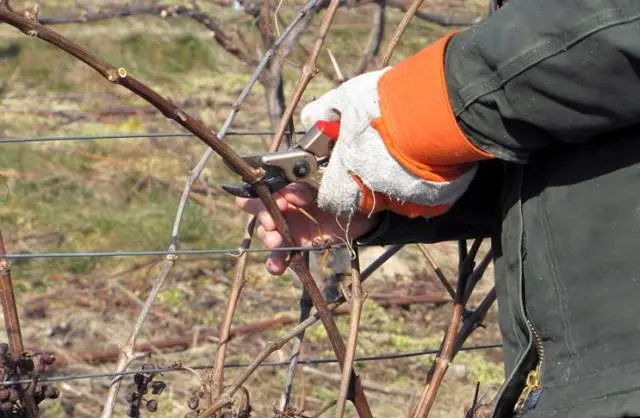
With the help of pruning, you can not only form young seedlings, but also reanimate frozen or overgrown shrubs. Grapes are a hardy plant, and if there is even one chance to restore and grow a crown, they need to be used.
You will learn how to properly prune running grapes in the spring from the video:
Formation of a young bush
The vine always stretches upwards, striving for sunlight and clinging with its tendrils to the trellis or support. If the formation of numerous shoots is not controlled, the bushes quickly overgrow, which leads to a decrease in yield and a deterioration in the quality of the fruit.
Therefore, when growing this crop, it is necessary to know how to properly prune grapes in the spring and form a vine.
In the first 3-4 years after planting, young vines are subjected to formative pruning. During this period, it is important to create the basis of the future vineyard – the sleeves, which will bear the entire load. The main branches are formed in several stages, depending on the way the vine is grown. There are two common shaping methods:
- Standard;
- Stemless.
In both cases, it is important to adhere to the recommended pruning scheme, while observing the deadlines, as well as the rules for subsequent care.
The difference between stem and non-stem formation is that in the first case, the main stem must be formed, from which the sleeves of the vine will subsequently depart. The height of the stem can vary from 0,2 m to 0,8 m.
With stemless shaping, the shoulders of the vine are formed from the basal head. The number of sleeves may vary. Most often, growers prefer to form 2- or 4-stem vines.
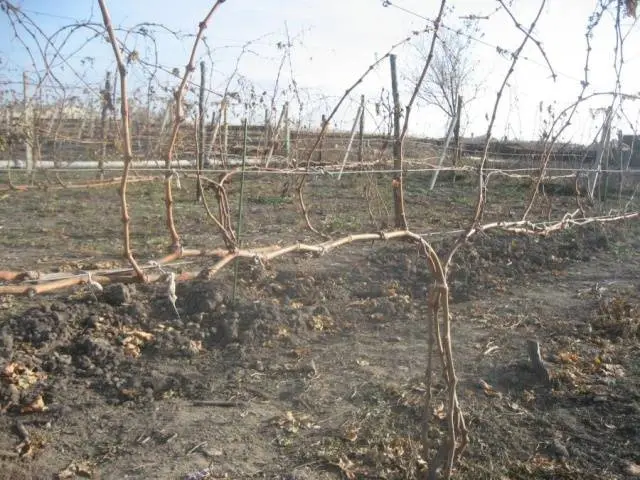
Subsequently, when forming grapes in the spring, you can cut off excess shoots, leaving a fruit link – an arrow and a replacement knot.
Proper and timely formation of a grape bush is the key to abundant and stable fruiting.
Stamp formation
A feature of standard shaping is that in this case, cutting the vine according to the indicated scheme is possible only if you grow grapes in an uncovered way. Varieties should be distinguished by high frost resistance. Most often, this method is used when growing grapes on an industrial scale, as well as residents of regions with a mild, warm climate.
The formation of the stem begins from the first year after planting the seedlings. Below is a scheme for pruning grapes in the spring for beginners in pictures:
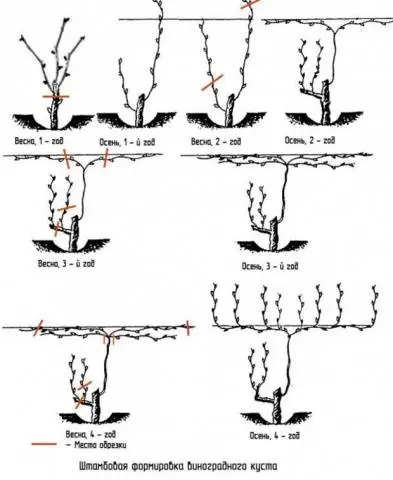
- For the 1st year: the top of the grape seedling is cut off. Counting from the root, leave two eyes for the growth of shoots. The rest of the growth must be cut out.
- For the 2nd year: the main stem – the stem – remains intact, and you will have to work with the shoots that grew last year. On a higher and more powerful shoot, the top should be cut off, leaving 7-12 buds on it, and the smaller sprout is left as a spare, it needs to be shortened, leaving only 2-3 eyes on it.
- For the 3rd year: during this period, the height and shape of the bole is formed. The two upper shoots – now these are the “sleeves” of the grapes – are shortened by 2 eyes and tied to a trellis or support. Reserve shoots are cut as follows: one is shortened by 2 eyes (this will be a replacement knot), and the second by at least 5-6 buds.
- Year 4: Trim off the top sleeves and unwanted shoots, allowing you to shape the grapes the way you want.
- For the 5th year: It is necessary to save only the main branches, which make up the fruit link, cutting off all unnecessary shoots.
- On the 6th year: when the fruit link is formed, the replacement knot is cut into 2 buds, the fruit arrow is shortened to 7-8 eyes.
Beginning gardeners can learn more about standard pruning of young grapes in spring from the video clip:
Stamp formation of grapes allows you to save space and at the same time get a bountiful harvest.
Stemless bush formation
The period of formation of the vine in this case is shorter. It allows you to form a full-fledged, fruit-bearing bush in just 3 years. But there are some subtleties in this procedure that distinguish it from the previous method. These differences are noticeable in the grape pruning scheme. Even a novice summer resident can easily find differences in standard and non-standard formations.

- For the 1st year: you need to remove all deformed, diseased, damaged shoots, as well as up to 90% of the young growth. The remaining 2 sprouts are cut off 2-3 cm above the second kidney.
- Year 2: Up to 60% of the young growth should be removed. On each sprout, 2 of the most powerful shoots are left, which subsequently will bear the entire load. They are shortened, leaving 2-3 eyes on each. By autumn, a large number of annual shoots will grow on them.
- For the 3rd year: it is important to correctly form the fruit links of the grapes. The lower vine (replacement knot) is cut into 2-3 buds, and the upper part (the so-called fruit arrow) is cut into at least 7-10 buds. Thus, you need to form each sleeve. It should have 2 full-fledged vines, the rest of the shoots can be removed.
Subsequently, when forming grapes, it is important to remember that for abundant fruiting, 2-3 replacement knots must be left for subsequent crown renewal, and fruiting shoots.
An experienced grower and the author of the video will tell you more about how to properly cut grapes in spring for beginner gardeners:
Features of annual pruning
Fruit-bearing vines also need annual pruning. After all, in this way you regulate the required number of shoots that are guaranteed to yield a crop, and you can lay the foundation for obtaining fruits next year.
Spring pruning of grapes is more of a renewing function. During this period, you need to remove:
- Fruiting branches (if you did not cut the grapes in the fall);
- Damaged, weak, diseased, frozen, thin shoots;
- “Greasing”, that is, too thick vines, the thickness of which is more than 6-10 mm.
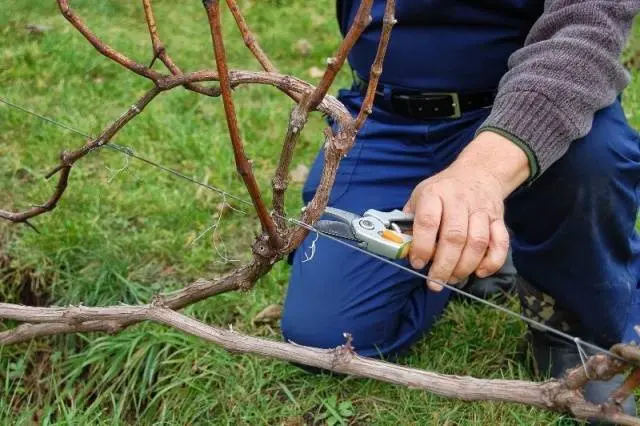
But it is important to remember that pruning grapes in spring and autumn is a single set of activities. Carrying out the spring procedure, do not forget about the autumn care of the plants. During autumn pruning, gardeners usually leave about twice as many buds as necessary, thereby creating a kind of reserve in case some of them do not survive the winter frosts.
Aftercare
After the spring pruning of grapes is carried out in accordance with all the rules, you will have to follow the standard care procedures:
- Regular loosening of the soil at a distance of up to 40-60 cm from the bush.
- Timely watering and fertilizing plants.
- Timely preventive treatment in order to protect against pests and diseases.
- Weeding.
- When shoots reach a length of 25 cm or more, they need to be bent and tied to a support, thus forming a vine for future crops.
Plants should be inspected every two weeks. During the period of formation and ripening of fruits, all fruit-bearing shoots must be well fixed, otherwise they may break off under the weight of the brushes.
Conclusion
It’s no secret that the correct and timely pruning of grapes in the spring is an important and very responsible event. If you approach this process with special diligence and attention, this sunny plant will thank you with a bountiful harvest of large, sweet and juicy berries.









